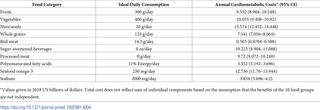Our official English website, www.x-mol.net, welcomes your
feedback! (Note: you will need to create a separate account there.)
Cardiometabolic disease costs associated with suboptimal diet in the United States: A cost analysis based on a microsimulation model.
PLOS Medicine ( IF 10.5 ) Pub Date : 2019-12-17 , DOI: 10.1371/journal.pmed.1002981 Thiago Veiga Jardim 1, 2 , Dariush Mozaffarian 3 , Shafika Abrahams-Gessel 2 , Stephen Sy 2 , Yujin Lee 3 , Junxiu Liu 3 , Yue Huang 3 , Colin Rehm 4 , Parke Wilde 3 , Renata Micha 3 , Thomas A Gaziano 1, 2
PLOS Medicine ( IF 10.5 ) Pub Date : 2019-12-17 , DOI: 10.1371/journal.pmed.1002981 Thiago Veiga Jardim 1, 2 , Dariush Mozaffarian 3 , Shafika Abrahams-Gessel 2 , Stephen Sy 2 , Yujin Lee 3 , Junxiu Liu 3 , Yue Huang 3 , Colin Rehm 4 , Parke Wilde 3 , Renata Micha 3 , Thomas A Gaziano 1, 2
Affiliation

|
BACKGROUND
Poor diet is a leading risk factor for cardiometabolic disease (CMD) in the United States, but its economic costs are unknown. We sought to estimate the cost associated with suboptimal diet in the US.
METHODS AND FINDINGS
A validated microsimulation model (Cardiovascular Disease Policy Model for Risk, Events, Detection, Interventions, Costs, and Trends [CVD PREDICT]) was used to estimate annual cardiovascular disease (fatal and nonfatal myocardial infarction, angina, and stroke) and type 2 diabetes costs associated with suboptimal intake of 10 food groups (fruits, vegetables, nuts/seeds, whole grains, unprocessed red meats, processed meats, sugar-sweetened beverages, polyunsaturated fats, seafood omega-3 fats, sodium). A representative US population sample of individuals aged 35-85 years was created using weighted sampling from National Health And Nutrition Examination Surveys (NHANES) 2009-2012 cycles. Estimates were stratified by cost type (acute, chronic, drug), sex, age, race, education, BMI, and health insurance. Annual diet-related CMD costs were $301/person (95% CI $287-$316). This translates to $50.4 billion in CMD costs (18.2% of total) for the whole population, of which 84.3% are attributed to acute care ($42.6 billion). The largest annual per capita costs are attributed to low consumption of nuts/seeds ($81; 95% CI $74-$86) and seafood omega-3 fats ($76; 95% CI $70-$83), and the lowest are attributed to high consumption of red meat ($3; 95% CI $2.8-$3.5) and polyunsaturated fats ($20; 95% CI $19-$22). Individual costs are highest for men ($380), those aged ≥65 years ($408), blacks ($320), the less educated ($392), and those with Medicare ($481) or dual-eligible ($536) insurance coverage. A limitation of our study is that dietary intake data were assessed from 24-hour dietary recall, which may not fully capture a diet over a person's life span and is subject to measurement errors.
CONCLUSIONS
Suboptimal diet of 10 dietary factors accounts for 18.2% of all ischemic heart disease, stroke, and type 2 diabetes costs in the US, highlighting that timely implementation of diet policies could address these health and economic burdens.
中文翻译:

在美国,与最佳饮食相关的心血管疾病成本:基于微观模拟模型的成本分析。
背景技术不良饮食是美国心脏代谢疾病(CMD)的主要危险因素,但其经济成本尚不得而知。我们试图估算与美国饮食欠佳相关的费用。方法和结果使用经过验证的微观模拟模型(风险,事件,检测,干预,成本和趋势的心血管疾病政策模型[CVD PREDICT])估算年度心血管疾病(致命和非致命性心肌梗塞,心绞痛和中风),以及与10个食物组(水果,蔬菜,坚果/种子,全谷物,未加工的红肉,加工的肉,加糖的饮料,多不饱和脂肪,海鲜omega-3脂肪,钠)的最佳摄入量相关的2型糖尿病成本。使用2009-2012年国家健康与营养检查调查(NHANES)的加权采样创建了具有代表性的美国35-85岁人口样本。根据成本类型(急性,慢性,毒品),性别,年龄,种族,教育程度,BMI和健康保险对估计值进行分层。与饮食相关的CMD年度费用为每人$ 301(95%CI $ 287- $ 316)。这意味着整个人口的CMD费用为504亿美元(占总费用的18.2%),其中84.3%来自急诊护理(426亿美元)。年人均成本最高的是坚果/种子(81美元; 95%CI为74-86美元)和海鲜omega-3脂肪的低消耗量(76美元; 95%CI为70-83美元)是最低的,其原因是高消费红肉($ 3; 95%CI介于$ 2.8- $ 3.5)和多不饱和脂肪($ 20; 95%CI介于$ 19- $ 22)。男性的个人花费最高(380美元),年龄≥65岁的人群($ 408),黑人($ 320),文化程度较低的人群($ 392),以及享有Medicare($ 481)或双重资格的人($ 536)。我们研究的局限性在于,膳食摄入量数据是根据24小时饮食召回来评估的,这可能无法完全捕捉一个人一生中的饮食,并且存在测量误差。结论在美国,十种饮食因素的次优饮食占所有缺血性心脏病,中风和2型糖尿病费用的18.2%,这表明及时实施饮食政策可以解决这些健康和经济负担。可能无法在一个人的一生中完全吸收饮食,并且容易出现测量误差。结论在美国,十种饮食因素的次优饮食占所有缺血性心脏病,中风和2型糖尿病费用的18.2%,这表明及时实施饮食政策可以解决这些健康和经济负担。可能无法在一个人的一生中完全吸收饮食,并且容易出现测量误差。结论在美国,十种饮食因素的次优饮食占所有缺血性心脏病,中风和2型糖尿病费用的18.2%,这表明及时实施饮食政策可以解决这些健康和经济负担。
更新日期:2020-01-14
中文翻译:

在美国,与最佳饮食相关的心血管疾病成本:基于微观模拟模型的成本分析。
背景技术不良饮食是美国心脏代谢疾病(CMD)的主要危险因素,但其经济成本尚不得而知。我们试图估算与美国饮食欠佳相关的费用。方法和结果使用经过验证的微观模拟模型(风险,事件,检测,干预,成本和趋势的心血管疾病政策模型[CVD PREDICT])估算年度心血管疾病(致命和非致命性心肌梗塞,心绞痛和中风),以及与10个食物组(水果,蔬菜,坚果/种子,全谷物,未加工的红肉,加工的肉,加糖的饮料,多不饱和脂肪,海鲜omega-3脂肪,钠)的最佳摄入量相关的2型糖尿病成本。使用2009-2012年国家健康与营养检查调查(NHANES)的加权采样创建了具有代表性的美国35-85岁人口样本。根据成本类型(急性,慢性,毒品),性别,年龄,种族,教育程度,BMI和健康保险对估计值进行分层。与饮食相关的CMD年度费用为每人$ 301(95%CI $ 287- $ 316)。这意味着整个人口的CMD费用为504亿美元(占总费用的18.2%),其中84.3%来自急诊护理(426亿美元)。年人均成本最高的是坚果/种子(81美元; 95%CI为74-86美元)和海鲜omega-3脂肪的低消耗量(76美元; 95%CI为70-83美元)是最低的,其原因是高消费红肉($ 3; 95%CI介于$ 2.8- $ 3.5)和多不饱和脂肪($ 20; 95%CI介于$ 19- $ 22)。男性的个人花费最高(380美元),年龄≥65岁的人群($ 408),黑人($ 320),文化程度较低的人群($ 392),以及享有Medicare($ 481)或双重资格的人($ 536)。我们研究的局限性在于,膳食摄入量数据是根据24小时饮食召回来评估的,这可能无法完全捕捉一个人一生中的饮食,并且存在测量误差。结论在美国,十种饮食因素的次优饮食占所有缺血性心脏病,中风和2型糖尿病费用的18.2%,这表明及时实施饮食政策可以解决这些健康和经济负担。可能无法在一个人的一生中完全吸收饮食,并且容易出现测量误差。结论在美国,十种饮食因素的次优饮食占所有缺血性心脏病,中风和2型糖尿病费用的18.2%,这表明及时实施饮食政策可以解决这些健康和经济负担。可能无法在一个人的一生中完全吸收饮食,并且容易出现测量误差。结论在美国,十种饮食因素的次优饮食占所有缺血性心脏病,中风和2型糖尿病费用的18.2%,这表明及时实施饮食政策可以解决这些健康和经济负担。











































 京公网安备 11010802027423号
京公网安备 11010802027423号